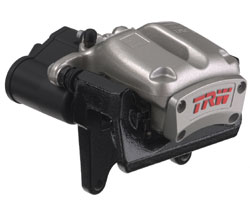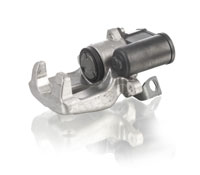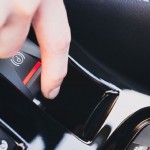ZF TRW recently announced production of its sixty millionth Electric Park Brake (EPB) motor-on-caliper unit. This was an important milestone for the company which highlighted the success of its EPB product portfolio, now in production in its fifth generation.
ZF TRW was first to market with its EPB system in 2001 which pioneered with Lancia, Audi and VW and has since launched on Renault, Nissan and Daimler platforms, and more recently on the BMW X4 and BMW i8, Jeep Renegade, Fiat 500X, Ford F150, Honda Accord, Nissan Qashqai, Range Rover Evoque and more.
The breakthrough technology was first developed at ZF TRW’s global technical centre in Koblenz, Germany and the company also now produces EPB in North America and China.
 There are two mechanisms currently used in vehicle production, cable puller systems and caliper integrated systems, such ZF TRW’s EPB.
There are two mechanisms currently used in vehicle production, cable puller systems and caliper integrated systems, such ZF TRW’s EPB.
In caliper integrated systems, the brake caliper provides a connection between hydraulic actuation of the foot brake and electrically actuated parking brake.
The motor or transmission unit (actuator), which operates the parking brake, is screw-fixed directly to the brake caliper housing. The parking brake is actuated via a switch in the vehicle interior. The absence of a hand brake lever frees up space inside the vehicle. With no hand brake cables, there are no temperature problems (such as freezing) or mechanical wear, offering optimum brake power in all conditions.
EPB is part of ZF TRW’s ongoing commitment to enhance overall brake system performance and driver safety and comfort. In addition to providing park brake functionality, EPB is a fully integral part of the brake system with features such as dynamic actuation and brake pad wear sensing and reduces the degradation associated with mechanical systems.
The EPB also helps enhances safety in emergency situations. For example, in the case of a hydraulic system failure (which is the only reason to apply the parking brake during driving), the rear wheels are alternately braked, so that breakaway of the vehicle caused by a blocked rear axle is ruled out.
 Further, the hill-hold function, which applies brakes to prevent roll-back when pulling away on a gradient, can also be implemented using the EPB. An example is driving into a full multi-storey car park. When vehicles are moving slowly, and the driver has to stop on a steep ramp, moving off smoothly is difficult. However, EPB solves this issue by being equipped with a drive away assist system. This opens the parking brake automatically when the engine provides sufficient torque to safely get the car moving. And in the unlikely event of the engine stalling and the car rolling backwards, the system detects this and automatically closes the parking brake.
Further, the hill-hold function, which applies brakes to prevent roll-back when pulling away on a gradient, can also be implemented using the EPB. An example is driving into a full multi-storey car park. When vehicles are moving slowly, and the driver has to stop on a steep ramp, moving off smoothly is difficult. However, EPB solves this issue by being equipped with a drive away assist system. This opens the parking brake automatically when the engine provides sufficient torque to safely get the car moving. And in the unlikely event of the engine stalling and the car rolling backwards, the system detects this and automatically closes the parking brake.
EPB Comfort and Safety Functions in Detail
Emergency braking – If the EPB switch is actuated while driving, it is interpreted by the system as emergency braking. As immediate full braking would result in blocking the rear axle and the car breaking away at the rear, the parking brake is instead closed and opened again in rapid succession (similar to the ABS function). This mode ensures safe braking of the car to a standstill.
Child safety lock – The parking brake cannot be released when the ignition is off.
Automatic hold – The parking brake can be applied automatically as soon as the driver’s door is opened or the ignition is switched off.
Electronically controlled – EPB is electronically, rather than mechanically-controlled meaning it can work with a variety of vehicle systems and sensors.
Design freedom for vehicle interiors – The EPB system, with its electronic cable and control switches, simplifies routing and allows for greater freedom of design for vehicle interiors. Its smaller package becomes even more attractive as vehicle manufacturers continue to requisition vehicle space for new standard features and options.
ZF TRW offers a range of EPB solutions including standard EPB, integrated EPB which removes the requirement for a separate Electronic Control Unit (ECU) due to its integration with the Electronic Stability Control system, and EPB for front axles which can help to make the technology more affordable for a smaller vehicle segments.










